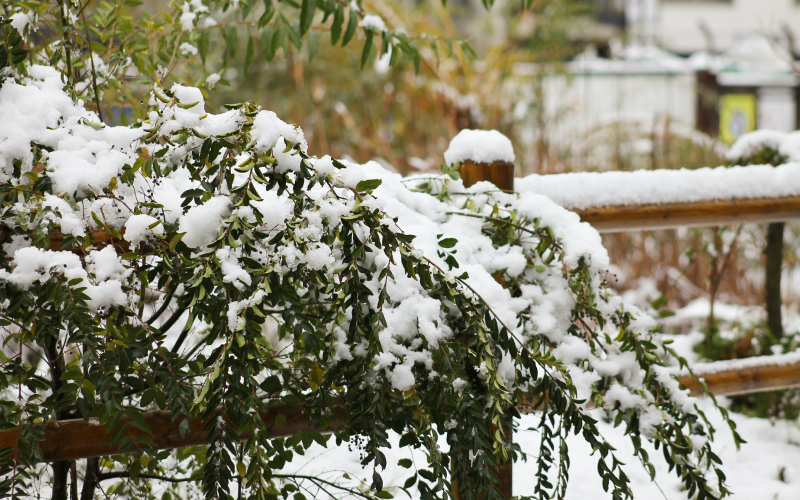Snow can be a good thing for our woody plants, providing insulation against cold temperatures and desiccating winds, anchoring root systems on trees with large sails, and with a little luck, providing the requisite levels of soil moisture come bud break. But this year, the maxim about too much of a good thing is ringing true.
As the thick blankets of snow are pulled back with the warmer weather and the promise of spring, we are beginning to see how our shrubs and small trees faired. So far, we have mostly seen the low growing broken lateral bows of lanky pines, and Japanese maples, their ends pressed to the ground under a load of snow, and tightly sheared, flat-topped yew hedges doing their best to carry listing loads of snow and ice with varying degrees of success. What remains to be seen are many of our smaller, lower-growing, foundation plantings that suffered the extra burden of snow thrown by shovels, plows, and pitched roofs. It is the rare gardener that has the horticultural avalanche rescue training required to locate and recover that prized azalea or the fothergilla installed last fall while the four-foot snowbank holds tight.
Most of us will have to wait patiently, honing our pruning tools and studying up on the growth habits of our different woody plants. Spring will be here before we know it however and then it will be time to make the hard decisions.
Ideally, you kept up with structure and maintenance pruning last season. Doing so tends to minimize damage caused by general snow loading. This work includes removal of dead or diseased branches, thinning, shaping and restraining where appropriate, and promoting a strong scaffold system of branches, removing limbs that will be prone to failure in the process.
Maybe you did the necessary pruning. Maybe you didn’t, but let’s consider the scenario that, nonetheless, you have damage to some woody plants. Now what? First, take stock of the damage. Does it appear to be terminal? If the plant is destroyed the decision will be, “Do I replace it with the same species, or try something more tolerant to snow loading for that location?” Alternatively, you could replace the damaged plant with the same species but prepare for next time with cultural techniques such as pruning and or barrier/enclosures.
Many of our landscape shrubs can be pruned back hard and rejuvenated over one to several years. When dealing with a flattened shrub, this is often the best approach. Before doing this, you should consult your reference books to see if the species in question will tolerate such treatment. For example, most conifers will not sprout from old wood. Taxus is the rare case of one that can. Forsythia, weigela, twig dogwood, lilac, hydrangea, and willow are some examples of genera that can be rejuvenated quite successfully.
For other woody plants damaged but salvageable, you may just need to take a breath, get over the loss of aesthetic, and deal with it. Initially, in many cases all that can be done is prune the broken branches out, always cutting back to a lateral branch or growing point. This, with proper mulching and fertilization, will allow the plant the best opportunity to respond with new growth.
Use the right tools for the job and make sure they are sharp. Seek out advice on proper techniques before diving in. Make good cuts, don’t plaster wound paint on damaged areas, be careful not to girdle limbs with wire in the process of tying damaged plant parts together. Call us if you are not sure what to do or if you would rather not take care of it yourself. Above all, treat your plants with respect.


